|
Inspector Quill:
Sleuthing in the Ballet and the Balkans
Malcolm J. Turnbull
The creative partnership of Caryl Brahms and S. J. Simon was one of the more pleasant cultural phenomena of the 1930s and 40s. The collaboration, which ended with Simon’s premature death in 1948, peaked in popularity during World War II when, intent on keeping Londoners laughing during the Blitz (and afterwards), B&S produced such gloriously surreal historical farces as Don’t Mr Disraeli and No Bed for Bacon, or the inspired fairy-tale spoof Titania Has a Mother. In my view, B&S’s finest and most enduring achievement was three marvellous comic crime novels, written slightly earlier. For want of a more precise label, I will refer to the trilogy as the Stroganoff-Quill saga. While a detailed discussion of “funny detective stories” is outside the scope of this relatively short paper [FOOTNOTE 1], it should be noted that a number of analysts and commentators have examined the nexus between comedy and crime in fiction. Northrop Frye, for instance, has placed the classical detective story, with its emphasis on ultimate restoration of societal harmony, firmly among the Comic Fictional modes. Arguing that the vast majority of British crime fiction has always been “comic in the broadest sense of the word”, Earl F. Bargainnier has highlighted the key influence of P.G. Wodehouse and Evelyn Waugh on the “cosy” writing of the Golden Age. Some critics have cited the detachment and essential bloodlessness of classical crime-writing as a logical reaction to the trauma of the Great War while others have viewed the flippancy of the 1920s-30s as an understandable reaction to the deadening seriousness of the standard pre-1920s supersleuth. FOOTNOTE 2. Manifestations of humour in the Golden Age detective story encompass everything from the use of comic set pieces and/or funny characters (as light relief), the injection of farcical situations, names, etc., to full-scale burlesque (as in Christie’s Partners in Crime or Bruce’s Case for Three Detectives). H.R.F. Keating has highlighted (a) what he calls the typically British humour of “gentle deflation”, taking the form of whimsical speech, comic names or delight in funny foreigners, and (b) the frequent choice of writers to exploit the laugh-potential of an incongruously-matched investigative duo. FOOTNOTE 3. One thinks immediately of such successors to Holmes & Watson as Poirot & Hastings, Sheringham & Moresby, Wimsey & Parker, Mrs Bradley and her chauffeur George, and (for our purposes) Quill & Clemenceau or Quill & Banner. The B&S crime trilogy contains a rich sampling of the elements and devices cited above. At its time, the series was regarded as an innovation. (Brahms herself has claimed that A Bullet in the Ballet founded a school of funny detection books.) [FOOTNOTE 4] In my view, the duo’s no-holds-barred contribution to the genre can be seen as a logical step in the ongoing process of leavening violent death into mass entertainment. Brahms began life as Doris Caroline Abrahams, born at Croydon in 1901, the only child of a prosperous jewellery wholesaler. Simon was born Seca Skildelsky in Manchuria in 1905. The pair first met at a student hostel in London in the 1920s. She was at the Royal Academy of Music; he, “like all Russians,” was studying forestry. Bonded by a mutual love of the ridiculous, they first collaborated professionally a decade later when the Evening Standard recruited them to provide comic captions for David Low’s celebrated political cartoons. By this time, Brahms had made a name for herself as a writer of Milne-style children’s verse and journalist specialising in ballet criticism. Simon, a devotee of complex gambling systems, was on the way to becoming an international authority on Contract Bridge. 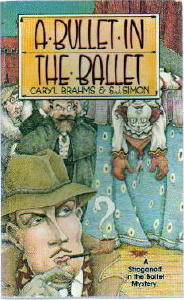 The duo drew extensively on their personal experiences – and on Simon’s first-hand knowledge of the expatriate White Russian communities in London and Paris – in their fiction. A Bullet in the Ballet is set in the London theatre world; its sequel merges ballet and casino milieux. FOOTNOTE 5. In referring to the B&S crime novels, Jane W. Stedman has written: “It is likely ... that readers of these works find less pleasure in clues and unravelment than in the ebullient collusion of fantastically comic characters.” [FOOTNOTE 6] Certainly the authors persistently subordinate puzzle and sleuthing to humour, yet all three books contain orthodox whodunit properties and conform in a number of regards to classic and Golden Age norms. B & S offer readers the obligatory corpses, circles of suspects (all with motives for mayhem), recountings of the investigation process, and climactic revelations of the culprits’ identities. One murder invariably leads to another. The Whitehall slayings (in Envoy on Excursion) are even described as “cosy” at one point. Casino for Sale poses a standard locked-room puzzle. In the same novel, Clemenceau’s fondness for growing marrows and roses are clearly homages to Agatha Christie’s Poirot and Wilkie Collins’s Sergeant Cuff. In the Buchanesque Envoy on Excursion, an hilariously harrowing train journey per the Trans-Mittel-Europa Rapide evokes Murder on the Orient Express. One scene, in which German agents uncouple and hijack a train carriage containing the British mission, gleefully recalls the Hitchcock films SECRET AGENT and THE LADY VANISHES (based on Somerset Maugham’s Ashenden and Ethel Lina White’s The Wheel Spins respectively.) Perhaps most importantly, the three books feature a series sleuth, Detective Inspector Adam Quill. FOOTNOTE 7. A Bullet in the Ballet (1937) came into being almost by accident. Brahms was deputising temporarily for fellow-critic Arnold Haskell on the Daily Telegraph. Summoned to a meeting with the newspaper’s managing editor, she arrived an hour early for the appointment with Simon in tow. The pair made profitable use of the hour by ordering a pot of tea at the Kardomah Cafe and devising a tongue-in-cheek detective story set within the London dance scene. Initially, the victim was to be Haskell, tossed in a blanket like the Corregidor in Three-Cornered Hat. “When that failed to ring true,” Brahms later wrote: ... we changed the ballet to Petrouschka and invented the victim ... Skid [i.e. Simon] took over the detection and the love
scenes and I did the ballet bits. Together we wrote the narrative
... [T]he work progressed happily, punctuated by Woodbine
cigarettes and frequent cups of tea, and shrieks of wild laughter.
FOOTNOTE
8.
A Bullet in the Ballet opens with the death of dancer Anton Palook, shot neatly through the forehead during a performance of Petrouschka. For beleaguered impresario Vladimir Stroganoff, the catastrophe is both annoying and ironic. Stroganoff has managed to guide his volatile company safely (if hysterically) through two years of touring Australia, middle America, Manchuria and the African coast, only to have Palook expire at the genteel Collodium on the first night of the London season. Palook may have been “asking for it for years ... but good Petrouschkas were scarce.” Scotland Yard promptly dispatches Detective Inspector Quill and Sergeant Banner to investigate the crime. There is no shortage of suspects: – half a dozen backbiting ballerinas, competitive premier danseurs and danseurs d’etoile, an inharmonious corps de ballet, a belligerent conductor, innumerable mamouschkas savagely defending the interests of their ambitious dancing daughters, the odd financial backer, disgruntled dressers, etc, etc. ... A startling percentage of the seething troupe (male and female) appears to have been caught up in Palook’s extensive and eclectic love life. Just about everyone Quill encounters seems to have a motive for wishing the detestable Palook out of the way. The Inspector wades methodically through the evidence only to have the likely culprit (the unpleasant Pavel, “the second most hated man in the company”) replicate Palook’s onstage death minutes before he is due to be arrested. It becomes clear that a serial killer is at work. With publicity about the Petrouschka slayings proving an unexpected windfall for the Ballet Stroganoff, a final murder is averted at the eleventh hour. In the course of A Bullet in the Ballet, we learn that the company emulates its more illustrious counterparts (like the De Basil troupe) by playing winter seasons in the south of France. In the case of the Ballet Stroganoff, this means performing at the Casino de La Bazouche. “To Stroganoff’s continual amazement,” we are told, “few dancers who survived the season at La Bazouche ever expressed the desire to go through another.” La Bazouche, “by no means Cannes ... not even Menton or Monte Carlo,” provides the setting for Casino for Sale (1938), published in America under the title Murder a la Stroganoff. 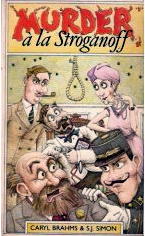 Temporarily rich “since my London season when my Petrouschkas so sensationally perish,” Vladimir Stroganoff is duped into buying the down-at-heel “Casino-by-the-sea” and thus finds himself in competition with the more impressive edifice and ballet troupe run by rival entrepreneur Lord Buttonhooke. Despite the defection of several of his star dancers to Buttonhooke, the eternally optimistic Stroganoff hopes to attract “the discerning public” with the skills of promising ballerina Ostrojno and a new work by avant-garde choreographer Nevajno. (“What matters it to me that Buttonhooke has the buildings, the publicity, the millions? ... It is not the millions that makes the success. It is the artistic directions.”) [page 15] A fly-in-the-ointment is ballet critic Pavlo Citrolo who is appalled by the new Nevajno opus and has no qualms about telling the reading/paying public so. Citrolo is a thoroughly unsavoury character. He ekes out his journalistic stipend through blackmail. “I am the old-fashioned villain,” he informs the ballerina Ostrojno. “Old-fashioned villains are always killed in the end,” she warns and, predictably, Citrolo is found murdered in Stroganoff’s office shortly afterwards. The scene might have been taken from a sleuth’s nightmare. There was the body, lolling against the armchair, its features horribly contorted. Beside it lay a revolver, an empty bottle of iodine marked “poison”, and a glass of milk – untouched. There was a bullet hole. It was not in the corpse ... There was a noose hanging from the ceiling. There was an armchair, overturned as though for luck, a half-smoked cigar on the mantelpiece and some promising-looking ash on the carpet. The safe was open. The bureau had obviously been ransacked. On the desk lay the prospectus of an appetising gold mine. [pages 59-60] In short order, Stroganoff is incarcerated as chief suspect. Quill, holidaying on the Riviera, comes to his rescue: Quill’s inquiries into the murder pit him
against zealous young French policeman, Gustave Clemenceau.
Between them they isolate the likely culprit only (as in Bullet) to have the designated murderer expire
(in this case, from cyanide poisoning) before an arrest can be
made. Casino for Sale climaxes in a frenzied contest between
Stroganoff and Buttonhooke to lure the divine Dyrakova out of
retirement. “The most enchanting Sugar Plum since Tefilova,”
Dyrakova has not danced “ever since Anton Palook he drop her in Aurore.” [page 23]
Stroganoff triumphs; in the process the murderer is finally unmasked (too late to prevent him escaping justice, however). The conclusion of the novel finds the company preparing for a season of one-night stands in Bolivia. Stroganoff, having effected a “flit-clair de lune” from his hotel, is serenely confident he will be able to unload the casino “for the profit immense.” Ever the optimist, a lovable mixture of childlike ingenuousness and breathtaking chutzpah, Vladimir Stroganoff is a great comic creation. Being gulled into acquiring a seedy gambling den is completely in character, yet managing to alleviate the discomforts of a prison cell by surrounding himself with champagne, caviar, a Persian rug and a divan, is equally so. Stroganoff embodies the axiom: the Show must go on: We must continue always. In Bled
there are riots – but my company it perform every night. Some
town in Mexico they kill the president in the entr’acte, but the Ballet
Stroganoff it ignore, and we give the last act to new president
... [Bullet,
page 113.]
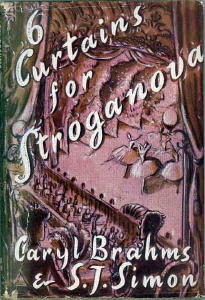 He is a philosopher (“My ballet needs money and the man who comes he has too mooch. It is fair that he lose a little...”) and he has no qualms about “talking up” the somewhat erratic splendours of his company. “I know I come only from Omsk but I have the vision”, he declaims proudly. [Six Curtains, pages 14, 67, 74] In the long run he knows what he is talking about. “The soul of that one will never die,” he assesses on first seeing the immortal Pavlova. Ultimately the ballet is Stroganoff’s whole life, its tempests, tribulations and triumphs all part of the rich fabric. The same might be said of Stroganoff’s two lieutenants, avant-garde choreographer Nevajno and ballet-mistress Arenskaya. Nevajno is a self-proclaimed genius responsible for dubious masterpieces like Gare du Nord (in which a railway station represents the Universe and a train Fate) or Ballet of the Shirts (in which the dancers are clad in aluminium and the set alternates a dungeon and a war-plane). Arenskaya, “a schooner doom-laden” and “a miniature virago of venom”, rules the troupe mercilessly and, despite their constant bickering, remains idiosyncratically loyal to Stroganoff throughout the saga. “I will never desert you”, she informs him grandly, “but also I will never, never give in to you when you are in the wrong, and this is the always.” [‘Brabble’, page 39] The third, and final, instalment of the Stroganoff-Quill saga relegates Vladimir and the Ballet Stroganoff to a mere cameo appearance. Quill takes centre stage in Envoy on Excursion (1940), written and set in the final months of 1939, during that uncertain period remembered as the “phoney war.” For the average Londoner, the immediate
aftermath of the declaration of war with Germany seemed somewhat
anti-climactic, entailing as it did Herculean efforts at sandbagging,
fittings for gas-masks, the construction of Anderson bomb-shelters in
back yards, and the explosion and penetration of bureaucracy into every
aspect of day-to-day living. The novel opens with the discovery
of a corpse in the office of Sir Humphrey Spratt, head of the Ministry
of Elimination. (The Department’s brief is to “supplement,
counteract and override the Ministry of Information.”)
Called in to investigate, Quill deduces that the unfortunate victim is none other than Auguste Sardinko, an emissary from the principality of Insomnia, in London to negotiate a treaty between his country and Britain. Insomnia, famed for its vodtsch (a mix of vodka and kirsch), picture postcards and pinball machines, is situated between Soviet Russia and Nazi Germany, and maintains its independence only through the reluctance of either power to let the other have it. Britain hopes to gain exclusive rights to Insomnia’s vast deposits of Gardenium, a substance which reportedly contains “just those qualities that make an armament manufacturer’s mouth water.” A second murder occurs. This time the victim, the standard “man who knew too much,” is found hanged in an air-raid shelter at Whitehall. Quill identifies the killer just as he (the killer) makes his escape to Holland. Clearly, his dastardly aim has been to thwart the signing of the treaty and to stir up anti-British feeling back in Insomnia. With the German Government eagerly intent on negotiating a treaty first, a British envoy, Mr Stung, is dispatched to Insomnia with all haste. Quill is ordered to accompany him as bodyguard. In the Insomnian capital Rumba Rumba, Quill finds himself playing a relentless game of cat-and-mouse with enemy agents. Attempts to sign the treaty are repeatedly frustrated (drugged cocktails, kidnappings, a time-bomb). Only the repeated non-arrival of the notoriously tardy German envoy, Franz Von Papern, allows the Brits breathing-space. At one point ‘our heroes’ find their railway carriage hijacked; then they are interned in a mediaeval fortress under the supervision of propaganda-spouting Nazis. The British Mission (which, by now, encompasses a pet Labrador) escapes into nearby Astoria and, from there, back to London. All its efforts, it eventuates, have been in vain. Germany signs a treaty with Insomnia but not before word has leaked back to the British cabinet that Gardenium is, in fact, worthless. 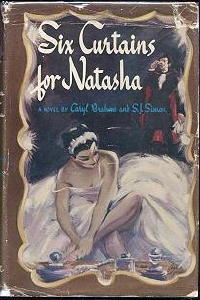 Disappointment over Envoy and its reception prompted
B&S to seek out new territory and they found fertile material for
their brand of inspired lunacy in the vagaries of British
history. They retained their affection for the Ballet Stroganoff
however, and in 1945 they published Six Curtains for
Stroganova, a non-criminous prequel to Bullet and Casino, set in St Petersburg circa
1910. A handful of Stroganoff short stories are also
extant. Quill is mentioned in passing in “Stroganoff, Said the
Duchess”, and he appears fleetingly in “A Bishop in the Ballet” and “A
Brabble in the Ballet,” the last two signed by Brahms alone and
apparently written in the 1970s. In the first, Quill (now a
Superintendent) intervenes when Stroganoff is suspected of
drug-smuggling. In the latter, he trails a confidence trickster
to Monte Carlo – and runs into the Stroganoff troupe. (The villain
flees before Quill can arrest him though). FOOTNOTE 9. Disappointment over Envoy and its reception prompted
B&S to seek out new territory and they found fertile material for
their brand of inspired lunacy in the vagaries of British
history. They retained their affection for the Ballet Stroganoff
however, and in 1945 they published Six Curtains for
Stroganova, a non-criminous prequel to Bullet and Casino, set in St Petersburg circa
1910. A handful of Stroganoff short stories are also
extant. Quill is mentioned in passing in “Stroganoff, Said the
Duchess”, and he appears fleetingly in “A Bishop in the Ballet” and “A
Brabble in the Ballet,” the last two signed by Brahms alone and
apparently written in the 1970s. In the first, Quill (now a
Superintendent) intervenes when Stroganoff is suspected of
drug-smuggling. In the latter, he trails a confidence trickster
to Monte Carlo – and runs into the Stroganoff troupe. (The villain
flees before Quill can arrest him though). FOOTNOTE 9.At his first appearance in Bullet, Adam Quill is a serious young man, 6 foot 3 in height, and the fortunate possessor of large capable hands, fair hair, a good-humoured mouth and an unemotional manner. Known in some quarters as the Adonis of Scotland Yard, he apparently lacks only the “practised profile” that distinguishes the matinee idol. [Bullet, p.162]. We learn very little about Quill’s non-professional life. At the time of the Petrouschka murders he is at the mercy of his landlady in lodgings at Earls Court. “[He] wondered why he, who faced cut-throats, blackmailers and con men unflinchingly, should lack the courage to give in his notice to Miss Treackle.” [Page 21.] By the end of the case, he is sufficiently infected with “the buoyancy of the Ballet Stroganoff” to assert himself at home; when Miss Treackle refuses to show the ballerina Rubinska up to his room, Quill threatens to vacate (and wins). If not a sportsman, he is clearly endowed with above-average physical fitness. (He tunnels out of Castle Gelt and bicycles across the border to Astoria in Envoy). In Casino, the astute Sadie Souse judges him out of place among card-sharpers in the south of France: “You look more the huntin’, shootin’, fishin’ type,” she speculates. A legacy from a rich aunt comes his way after Bullet and, in the short story “Stroganoff, Said the Duchess,” we learn that he is, in fact, a nephew of the formidable Duchess of Dumpshire. Apart from a passing reference to the girl behind the tobacco kiosk and a suggestion that his assigned driver, Belinda Biggs, might view him as a potential “war-time substitute” for a boyfriend (in Envoy), romantic entanglements are conspicuously absent from Quill’s life. In looks, physique and pedigree, therefore, Quill conforms to the Wimsey-Campion-Alleyn school of well-born omniscient sleuth. He defies the stereotype in one important regard, however. Quill is a conspicuously unsuccessful investigator, a prime example of the “defective detective” pioneered by E.C. Bentley (in Trent’s Last Case) and perpetuated by farceurs (to employ Julian Symons’s term) such as A. A. Milne (The Red House Mystery), Ronald Knox (The Viaduct Murder) and Anthony Berkeley. In practice, he is much closer to the intermittently insightful Roger Sheringham (Berkeley’s entertainingly fallible amateur investigator) than to the likes of Poirot, Thorndyke, Alleyn or Fortune. Quill is a big fan of Freeman Wills Croft’s industrious Inspector French. He is neither “supernaturally intelligent” nor “unnaturally stupid”; he joined the Police Force as a careerist and has risen through the ranks by industry and calling everyone “sir.” His best friends had never called Quill a brilliant detective. But he was conscientious and capable. His reports of a case were invariably masterpieces of lucid penetration, hailed as such by Scotland Yard and passed on to abler detectives for solution. [Casino, page 82.] In the Inspector’s view, detection is basically a mix of applied psychology and endless routine work. Like Inspector French, he prefers, whenever possible, to set out crime details in timetable form. The Petrouschka murders are his second big case since attaining senior rank. He is only too aware of the wisdom of Rule 39 of the Detective Handbook: “To travel cautiously is better than to fall down”. To remind him of this there was the awful example of his last case: a small matter of destruction by fire of a block of service flats, a restaurant and Bridge club, the owner of which not only possessed a heavy overdraft, no tenants, and an insurance policy due to lapse the following week, but had been observed just before the outbreak, fondling a tin of petrol. [Bullet, page 60.] To Quill’s chagrin, it had been proved at the trial that the suspect had been carrying petrol to his car a quarter of a mile away and that the fire had been the result of a gas leak. (The accused sued for wrongful arrest and “cleaned up a packet.”) Even so, he is initially reasonably complacent when called in to investigate Palook’s death. From what little he knew of the stage, actors were a jumpy crowd and it should be a matter of mere routine to discover a suspect to fill the three cardinal clauses in the Detective’s Handbook – Means, Motive, Opportunity ... As likely as not, he reflected, he would be greeted by some hysterical young woman already in the throes of repentance. [Bullet, pages 9-10.] Quill’s preconceptions and sensibilities are promptly assaulted by the rich emotionalism, egotism and eccentricity of the Ballet Stroganoff. Traditional methods (as per his Bible, the Detective’s Handbook) prove “singularly unhelpful.” Arenskaya, in particular, upsets all his notions of orthodox interrogation, being only too willing to talk (if harder to keep to the point) and supremely “at ease” in interview. Humbled, he can only shake his head in disbelief at Inspector Clemenceau’s sublime self-confidence. (“It is my first murder. But I have read and I assure M’sieur that I am capable,” Gustave confides blithely [Casino, page 61.]) Clemenceau elicits Quill’s grudging admiration: “He himself would never have the confidence to make an arrest within two seconds of seeing the victim.” Inevitably, he finds himself wondering “... if, when the mistake was discovered, the comments of the Surete to Gustave would, in their essentials, equal the comments made to him by Scotland Yard when, after some three weeks of hesitation, he had arrested the wrong man.” (As it happens, the Prefet notifies Gustave that while quick arrests might be useful, “... one must always arrest with discrimination.”) [pages 60, 165] There are indications that Quill feels some disappointment at his own lacklustre professional achievements. When the murder weapon is recovered in Bullet, he experiences “the emotion felt by the celebrated Inspector French at least a dozen times in every volume. That is to say he was delighted.” [Bullet, pages 76-77.] 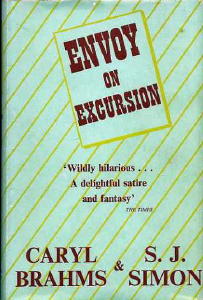 Such moments are relatively rare, however. He is understandably discomfited by the suspicion that the general public knows him only for his tendency to arrest the wrong person. Lying bound and gagged in a Central European hotel room, a time-bomb ticking beside him, and “looking exactly like the hero on the jacket of a 10-cent pulp,” Quill resolves to die “like an Englishman, With calm.” His one regret is never having solved a case. [Envoy, pages 58, 149.] In the long run though, lack of brilliance does not seem to impede his career. Following the Petrouschka slayings, he retires briefly and sets up his own detective agency. (The prospect of a two-week holiday on the Riviera lands him at the centre of the casino murder investigations.) World War II finds him back with Scotland Yard “for the duration”, heading the Department for the Protection of Neutrals from an oast-house in Kent. (The fact that he has won the promotion on the strength of his experience “in coping with the foreign mentality” might be regarded as “one of the funnier jokes of the war.”) He is working for the Foreign Office by war’s end and by the time of the short story “Bishop in the Ballet,” he has attained the rank of Assistant Commissioner. In that capacity, he is able to order the release of his old friend when “Stroggy” is detained by British Customs for trying to smuggle cocaine through Heathrow. In Bullet, Quill is accompanied by Sergeant Banner, a down-to-earth and enthusiastic young policeman who gets his best results taking young girls out to supper. (“All women talk better over steak and chips.”) The unimaginative Banner is distinctly red-faced when his “diplomatic approach” to a young male dancer is misinterpreted as “a suggestion of quite a different sort.” He resurfaces in Envoy, having moved up to C.I.D. and “civvies” (including bowler hat). Their chief at the Yard is popularly known as “The Snarl.” In Quill’s view, The Snarl “ought to have been a ballet critic,” having reached: ... the enviable position from
which he had nothing to do but criticise the efforts of others.
This duty he performed with the detachment of a Constant Lambert and
the invective of a James Agate – though unfortunately not in French.
To the Inspector’s delight it turns out that The Snarl had nurtured an infatuation for Arenskaya, years earlier, when called in to investigate the famous St Petersburg pearls case. (“She was very very beautiful”, the old policeman reminisces, “so beautiful that I could not find it in my heart to be cross with her when the stolen pearls turned out to be a stunt for the papers – the first of its kind, I believe.”) [Bullet, pages 64, 70, 92, 94.] Stylistically, B&S gleefully mixed parody, running gags,. literary allusions, comic verbal exchanges, outlandish dramatis personae, and picaresque set-pieces, into a distinctive whole. The Stroganoff-Quill novels, in particular, are distinguished by the quality of the writing and by the authors’ deft manipulation of major and minor characters within the traditional whodunit or thriller formulae. B&S offer detection enthusiasts surreal scenarios in which malfeasance and retribution are secondary to the sheer lunacy surrounding them. Writers like Leo Bruce, Pamela Branch, Marion Mainwaring and Joyce Porter have since played all-stops-out variations on comic crime but (in my view) no one to date has matched the relentless and enchanting ludicrousness of Bullet and its fellows. An eminent panel, comprised of H.R.F. Keating, Dorothy B. Hughes, Melvyn Barnes and Reginald Hill, once awarded Bullet a generous 7 points, out of a possible 10, for readability and characterisation in an international consumer guide to crime fiction. Elsewhere, Art Bourgeau has deemed the novel a classic. Reviewers have likewise dubbed Casino for Sale “phantasmagorical,” “far funnier than life” or a “gorgeous piece of fooling.” FOOTNOTE 10. Envoy on Excursion, which even the authors regarded as a failure on first appearance, reads much better today than it possibly could when the Nazis were actually occupying Western Europe. (It is all much ado about nothing in the Alfred Hitchcock mode, with an elusive treaty serving as the MacGuffin.) Recalling my own delight at my first encounter with the Stroganoff-Quill saga twenty years ago – and my continued enjoyment of their exploits and intrigues, I can only lament the fact that these hilarious books remain “neglected treasures.” FOOTNOTES: 1. This paper is drawn from a larger work-in-progress, tentatively titled Poor Man’s Thackeray: The Legacy of Caryl Brahms. 2. Earl F. Bargainnier: “Introduction” to Comic Crime (ed. E.F. Bargainnier), Bowling Green: Popular Press, 1987, pages 1-4; L.L. Panek: An Introduction to the Detective Story, Bowling Green: Popular Press, page 127; Elaine Bander: ‘“What Fun: Detection as Diversion” in Comic Crime, page 53; Lizabeth Paravisini & Carlos Yorio: “Is It or Isn’t It? The Duality of Parodic Detective Fiction,” in Comic Crime, page 181. 3. Bargainnier, pages 3-4; Panek, pages132-133, 137; H.R.F. Keating: “Comedy and the British Crime Novel” in Comic Crime, pages 7-22; H.R.F. Keating: The Bedside Companion to Crime, Mysterious Press, 1989, pages 94-100. 4. Caryl Brahms & Ned Sherrin: Too Dirty for the Windmill: A Memoir of Caryl Brahms, Constable, 1986, p.117. 5. Biographical information on B&S can be found in Too Dirty for the Windmill, passim. 6. Jane W. Stedman, “Caryl Brahms” in Twentieth Century Crime & Mystery Writers, ed. J. Reilly. 2nd edition; St Martin’s Press, 1985, pages 94–95. 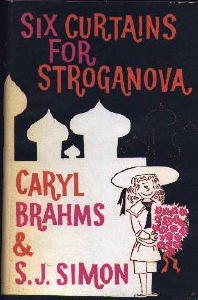 7. Editions of the Stroganoff-Quill novels cited in this paper are: Caryl Brahms & S.J. Simon: A Bullet in the Ballet, Penguin, 1942 [1937]. — : Casino for Sale, Michael Joseph, 1938. — : Envoy on Excursion, London: Michael Joseph, 1940. — : Six Curtains for Stroganova, Penguin, 1953 [1945]. 8. Too Dirty for the Windmill, pages 38-39, 45-46. 9. Within the extraordinary and anarchic comic world created by B&S, characters flit merrily from book to book, turning up fleetingly in highly unlikely places and situations. Stroganoff is a prime example. In addition to his appearances in Bullet, Casino, Envoy, Six Curtains and the short stories cited here, Stroganoff makes cameo appearances (without Quill) in The Elephant is White (1939), Don’t Mr Disraeli (1940), and the last B&S title You Were There (1950). Stroganoff, again sans Quill, inspired a further B&S short story, “A Contract in the Ballet,” and one by Brahms alone, “A Kidnap in the Ballet.” Of these, only “Kidnap” can be regarded as in any way criminous: Stroganoff agrees to a staged kidnapping in order to stir up much-needed publicity for the company. His inspiration is the press furor that surrounded the disappearance of Agatha Christie in 1926. “Stroganoff said the Duchess” appeared in the B&S collection To Hell with Hedda, Michael Joseph, 1947; the other stories appeared in Stroganov in Company: Collected Stories by Caryl Brahms, Robson, 1980. 10. B. Hughes, Reginald Hill, Melvyn Barnes & H.R.F. Keating: “Writers and their books: a Consumers’ Guide” in Whodunit: A Guide to Crime, Suspense and Spy Fiction, ed. H.R.F. Keating, Van Nostrand, 1982, page126; Art Bourgeau: The Mystery Lover’s Companion, Crown, 1986, page120; Saturday Review, 24 Sept 1938; details from dust jacket of omnibus Stroganoff in the Ballet, Michael Joseph, 1975. This article first
appeared in CADS #44, October
2003. Copyright © 2003,
2006 by Malcolm J. Turnbull.
CADS is a British mystery fanzine published irregularly by Geoff Bradley, 9 Vicarage Hill, South Benfleet, Essex SS7 1PA, England. For a sample issue, send £5.50 (UK) or $11 (US/Canada, airmail). Please make checks payable to G. H. Bradley. YOUR COMMENTS ARE WELCOME. |